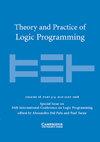慢性病门诊就诊调度答案集规划中基于逻辑的弯曲分解
IF 1.1
2区 数学
Q3 COMPUTER SCIENCE, SOFTWARE ENGINEERING
引用次数: 0
摘要
在答案集编程(ASP)中,用户可以声明性地定义一个问题,并使用高效的求解器进行求解;ASP的实际应用数不胜数,已经成功地解决了一些约束问题。另一方面,对于实例的大小,求解时间通常以超线性(通常是指数)的方式增长,这对于大型实例来说是不切实际的。一种广泛使用的方法是将优化问题分解成顺序求解的子问题,其中一些子问题使用其他子问题的赋值,然后通过并置单个子问题的解来重建整个问题的有效赋值。一方面,由于超线性行为,这种方法要快得多;另一方面,它不提供任何最优性保证:只分配一个SP可能会从搜索空间中排除最优解。在其他研究领域,基于逻辑的Benders分解(LBBD)被证明是有效的;在LBBD中,问题被分解为一个主问题(MP)和一个或几个主问题(sp)。MP的解决方案被传递给可能出现故障的sp。在失败的情况下,将一个no-good返回给MP,并通过添加新约束再次解决该问题。迭代求解过程,直到得到所有sp的有效解或证明MP不可行为止。所得解在非常温和的条件下是最优的。本文首次将LBBD应用于ASP,并以其在医疗保健中的应用为例进行了研究。实验结果表明了该方法的有效性。我们相信,LBBD的可用性可以进一步提高ASP技术的实际适用性。本文章由计算机程序翻译,如有差异,请以英文原文为准。
Logic-Based Benders Decomposition in Answer Set Programming for Chronic Outpatients Scheduling
Abstract In answer set programming (ASP), the user can define declaratively a problem and solve it with efficient solvers; practical applications of ASP are countless and several constraint problems have been successfully solved with ASP. On the other hand, solution time usually grows in a superlinear way (often, exponential) with respect to the size of the instance, which is impractical for large instances. A widely used approach is to split the optimization problem into subproblems (SPs) that are solved in sequence, some committing to the values assigned by others, and reconstructing a valid assignment for the whole problem by juxtaposing the solutions of the single SPs. On the one hand, this approach is much faster due to the superlinear behavior; on the other hand, it does not provide any guarantee of optimality: committing to the assignment of one SP can rule out the optimal solution from the search space. In other research areas, logic-Based Benders decomposition (LBBD) proved effective; in LBBD, the problem is decomposed into a master problem (MP) and one or several SPs. The solution of the MP is passed to the SPs that can possibly fail. In case of failure, a no-good is returned to the MP that is solved again with the addition of the new constraint. The solution process is iterated until a valid solution is obtained for all the SPs or the MP is proven infeasible. The obtained solution is provably optimal under very mild conditions. In this paper, we apply for the first time LBBD to ASP, exploiting an application in health care as case study. Experimental results show the effectiveness of the approach. We believe that the availability of LBBD can further increase the practical applicability of ASP technologies.
求助全文
通过发布文献求助,成功后即可免费获取论文全文。
去求助
来源期刊

Theory and Practice of Logic Programming
工程技术-计算机:理论方法
CiteScore
4.50
自引率
21.40%
发文量
40
审稿时长
>12 weeks
期刊介绍:
Theory and Practice of Logic Programming emphasises both the theory and practice of logic programming. Logic programming applies to all areas of artificial intelligence and computer science and is fundamental to them. Among the topics covered are AI applications that use logic programming, logic programming methodologies, specification, analysis and verification of systems, inductive logic programming, multi-relational data mining, natural language processing, knowledge representation, non-monotonic reasoning, semantic web reasoning, databases, implementations and architectures and constraint logic programming.
 求助内容:
求助内容: 应助结果提醒方式:
应助结果提醒方式:


